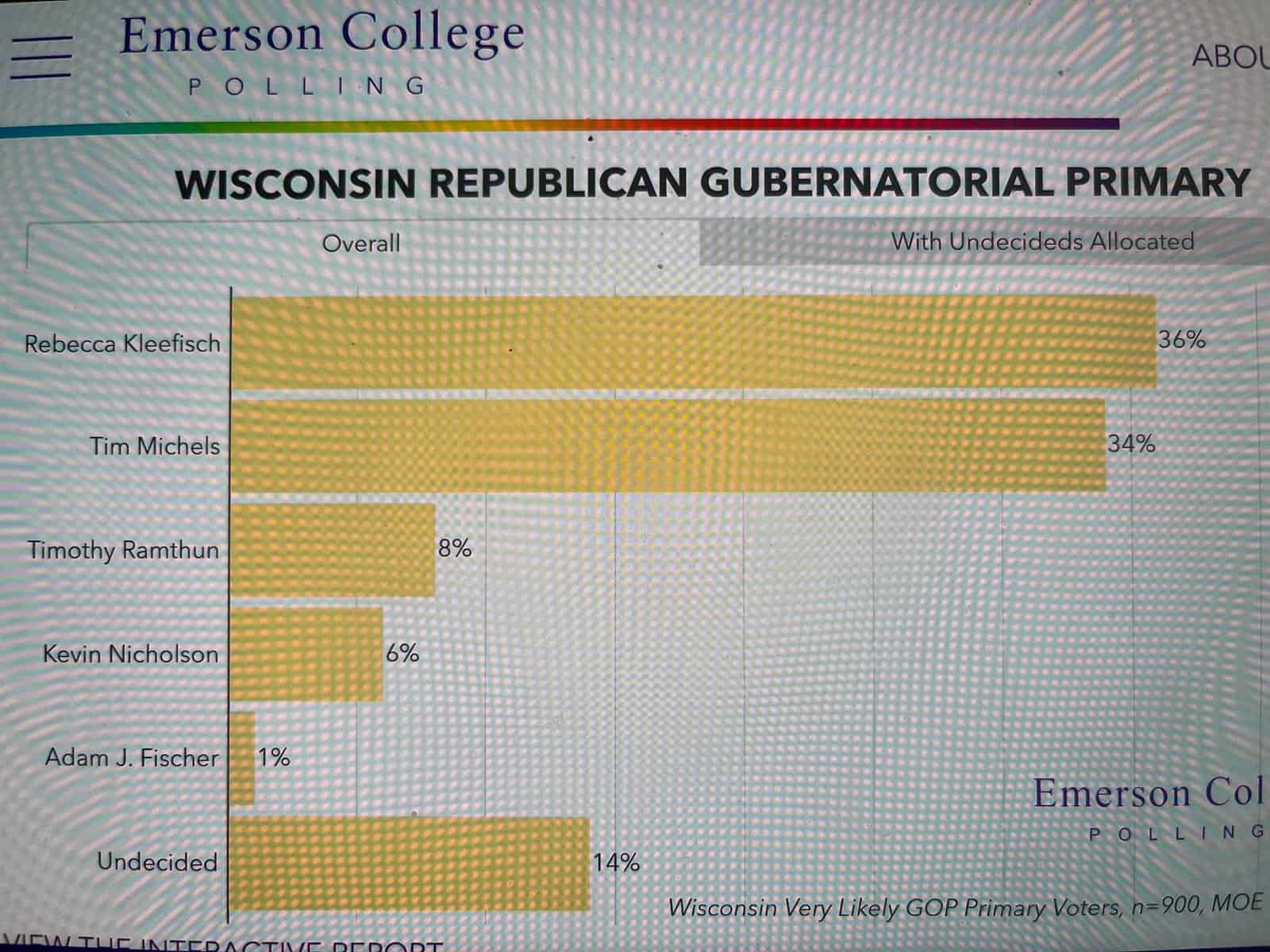The exceptionally close race and Kleefisch’s strong support among suburban voters may help explain why President Trump trashed Kleefisch and her family on Friday night in Waukesha.
Former Lt. Gov. Rebecca Kleefisch has a slight lead over construction company owner Tim Michels, but it’s in the margin of error, according to new poll from Emerson College. Voters in more populous suburban areas are giving her the small edge.
In the Emerson poll, which surveyed “very likely Republican primary voters, Kleefisch was supported by 36%, Michels by 34%, Tim Ramthun by 8%, and 14% are still undecided.
The tight race may help explain the ugliness that has erupted in the Republican primary. Former President Donald Trump, who has endorsed Michels, eviscerated Kleefisch and her family in a rally held in suburban Waukesha County that was attended by about 2,500 people. (See our column on those last-minute negative attacks here.)
Trump underperformed in the suburban areas where Kleefisch is now strongest in the 2020 election. Kleefisch has been running a WOW county strategy that is reminiscent of Scott Walker’s, who won by running up tallies in the suburban belt counties to offset the rest of the state.
The poll was conducted from August 3-5, 2022.
When undecided voters were asked who they lean towards, Kleefisch still led with 41% to Michels with 39%.

Former Marine Kevin Nicholson, who is still on the ballot but isn’t even running anymore, had 6%. Nicholson has said he is not endorsing anyone in the race. Where that 6% goes when people get into the voting booth, if it goes anywhere else, could determine the primary.
Ramthun’s support has grown somewhat since the last poll. Some Ramthun supporters were upset because they were told to turn Ramthun shirts inside out at the Trump rally, even though Ramthun is the only candidate supporting election decertification.
It’s the reverse of the last public poll in the race, by Marquette Law School, which came out in late June and showed Michels with a 1% lead, but in the margin of error. There has been no reliable polling until now.
“There is a clear regional divide for Wisconsin Republican voters,” says Spencer Kimball, Executive Director of Emerson College Polling. “Kleefisch holds a 21-point lead over Michels among suburban Wisconsin voters, whereas Michels has a similar margin over Kleefisch among rural voters, leading by 15 points.”
12.8% have already voted.
2.2% of the “very likely Republican Party primary voters” are Democrats, 64.8% are Republicans, and 33% are Independents. The Democratic voters may be crossing over to cause havoc because there is no longer a competitive Democratic primary for U.S. Senate.
When asked who they are leaning toward, the undecided voters in the poll said, 8% for Kevin Nicolson, 34.7% for Rebecca Kleefisch, 7.4% for Timothy Ramthun, 3.3% for Adam Fischer, and 33% for Tim Michels.
According to the Emerson poll, 39% of Republican voters say Trump’s endorsement “makes them more likely to support a candidate.” About 11% “are less likely to support a candidate with Trump’s endorsement,” and “nearly half (49%) say it makes no difference.”
Of course, which voters turn out in greater numbers also will likely decide the primary election.
Michels is viewed slightly more favorably than Kleefisch, though, although their unfavorables are almost even.
Both Kleefisch and Michels have net favorability ratings, according to the poll: “69% have a very (35%) or somewhat (34%) favorable view of Kleefisch while 74% have a very (37%) or somewhat (37%) favorable view of Michels.”
Most Republican primary voters say the economy is the most important issue (67%), with crime coming in second (11%).
President Joe Biden is wildly unpopular – 93% disapprove of the job he is doing.
“The Emerson College Polling survey of the Wisconsin Republican primary was conducted August 3-5, 2022. The sample consisted of very likely Republican primary voters, n=900, with a margin of error (MOE) of +/- 3.2 percentage points. The data sets were weighted by gender, age, region, and education based on 2022 turnout modeling. It is important to remember that subsets based on demographics carry with them higher margins of error, as the sample size is reduced. Data was collected using a cellphone sample using SMS-to-web and an Interactive Voice Response (IVR) system of landlines.”





















![WATCH: Elon Musk Town Hall Rally in Green Bay [FULL Video]](https://www.wisconsinrightnow.com/wp-content/uploads/2022/04/Elon_Musk_3018710552-356x220.jpg)











